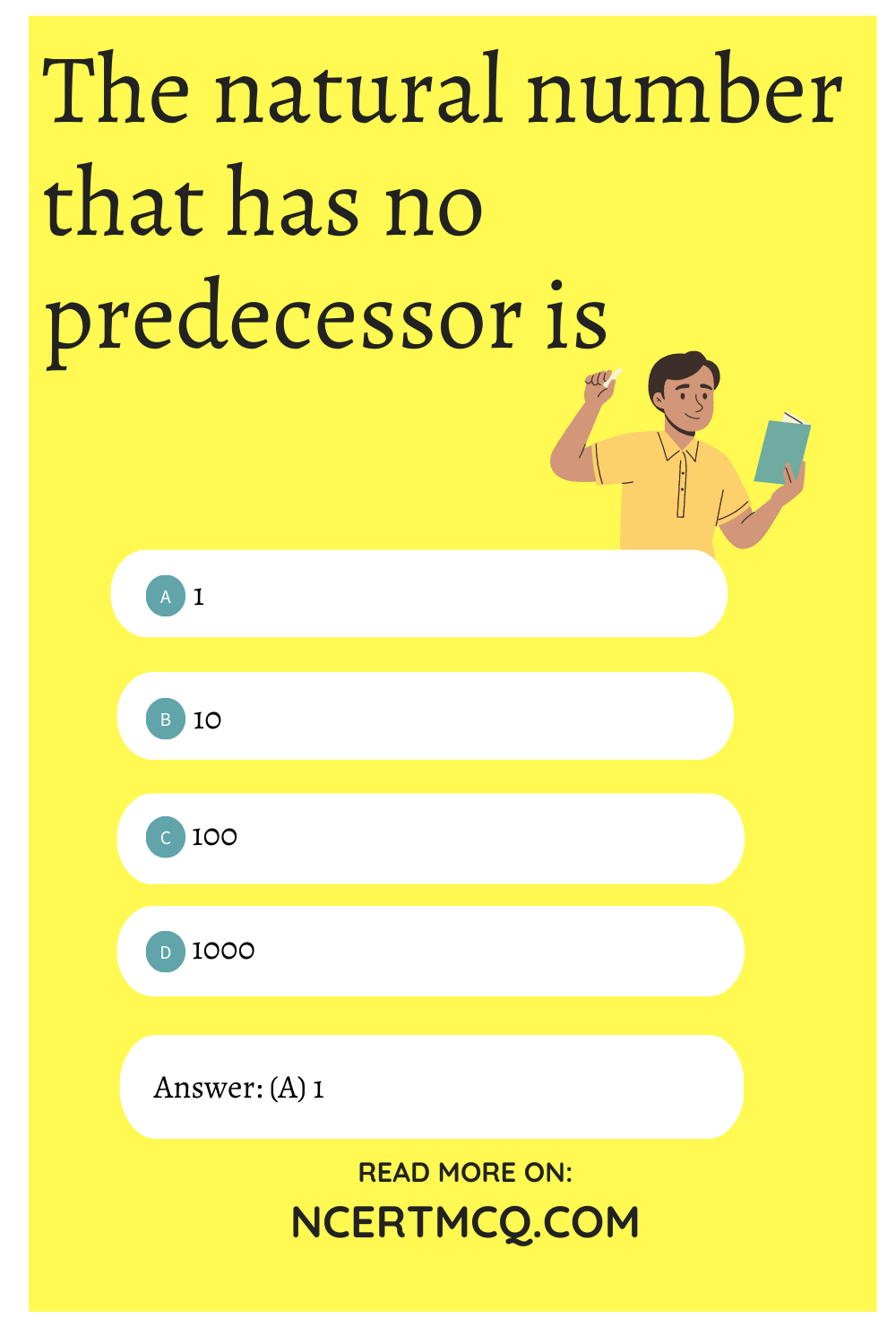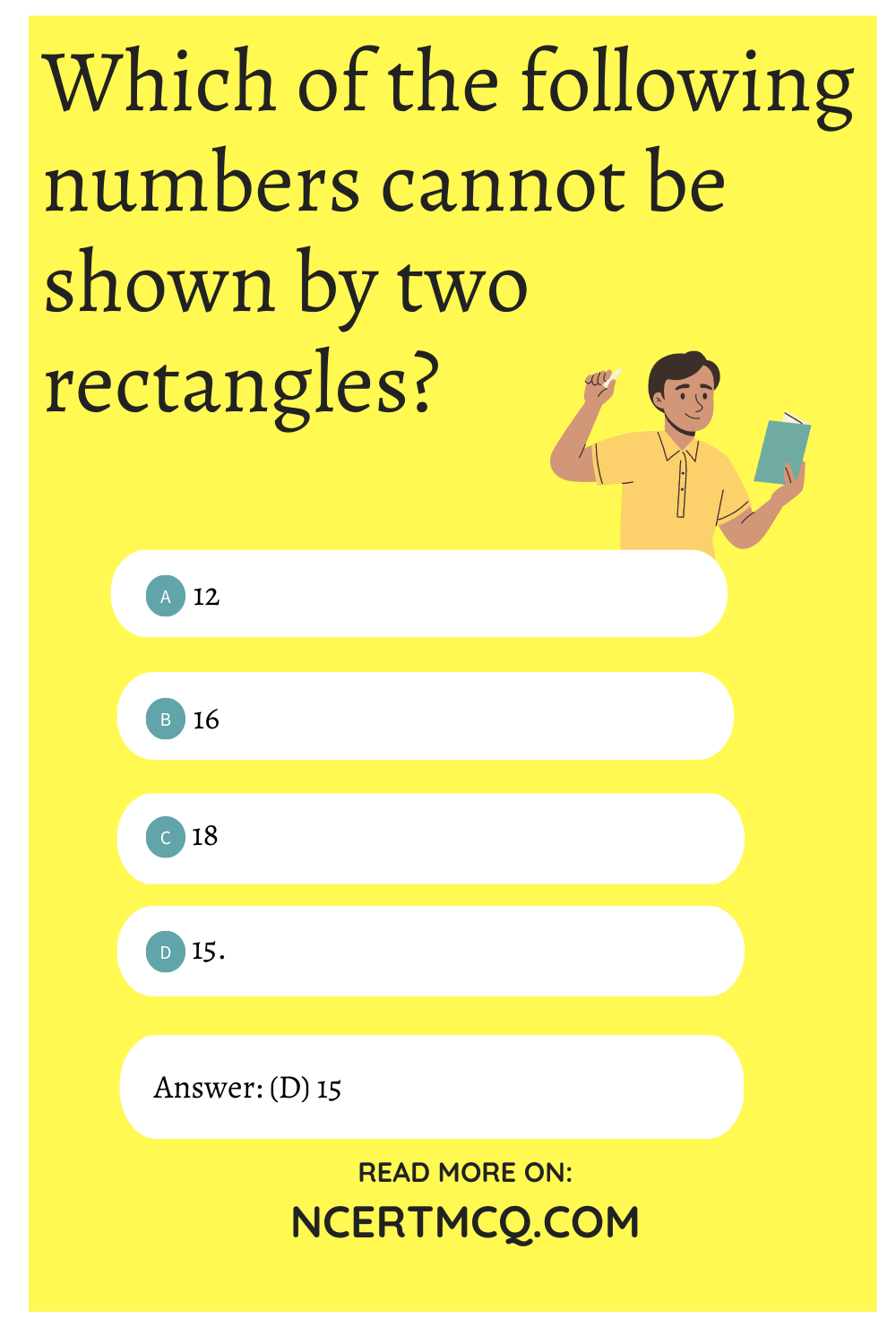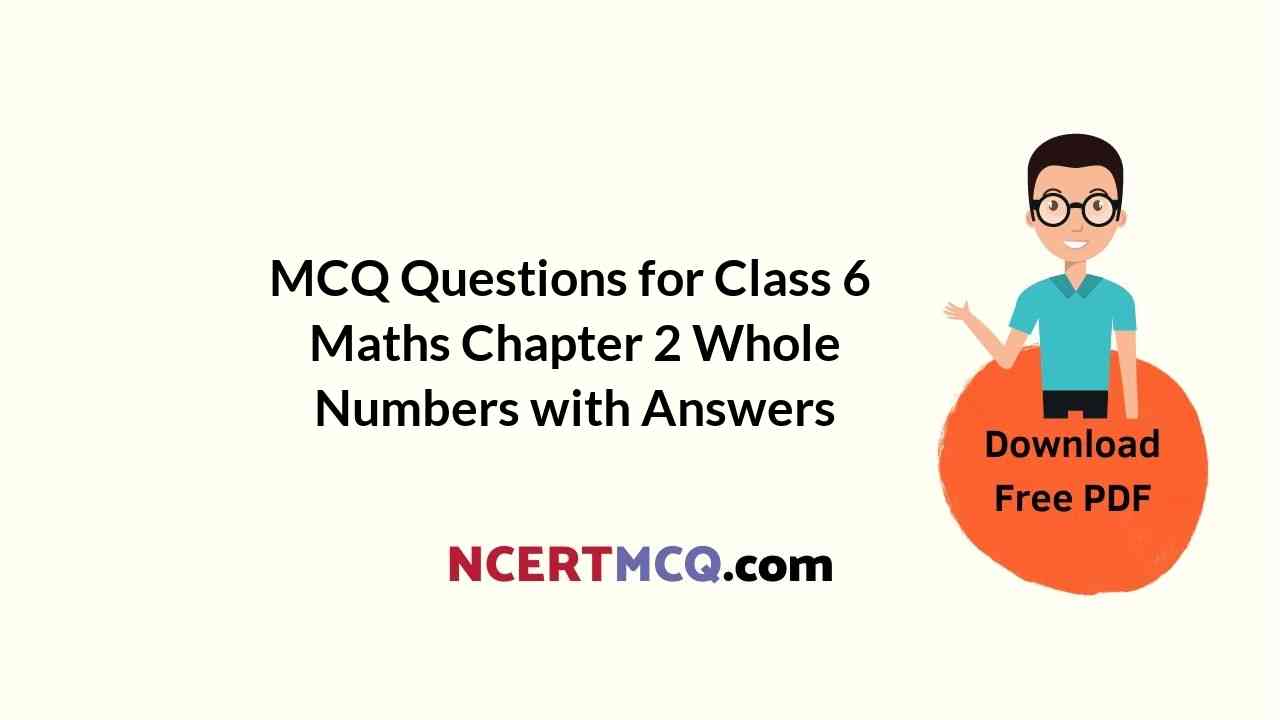Check the below NCERT MCQ Questions for Class 6 Maths Chapter 2 Whole Numbers with Answers Pdf free download. MCQ Questions for Class 6 Maths with Answers were prepared based on the latest exam pattern. We have provided Whole Numbers Class 6 Maths MCQs Questions with Answers to help students understand the concept very well.
Students can also refer to NCERT Solutions for Class 6 Maths Chapter 2 Whole Numbers for better exam preparation and score more marks.
Whole Numbers Class 6 MCQs Questions with Answers
MCQ Questions For Class 6 Maths Chapter 2 Question 1.
The successor of 99 is
(a) 99
(b) 98
(c) 100
(d) none of these.
Answer
Answer: (c)
Whole Numbers Class 6 MCQ Question 2.
The predecessor of 100 is
(a) 101
(b) 100
(c) 99
(d) none of these.
Answer
Answer: (c)
Class 6 Maths Chapter 2 MCQ Question 3.
The successor of 27 is
(a) 26
(b) 25
(c) 24
(d) 28.
Answer
Answer: (d)
MCQ On Whole Numbers For Class 6 Question 4.
The predecessor of 36 is
(a) 34
(b) 35
(c) 33
(d) 37.
Answer
Answer: (b)
Whole Numbers MCQ Class 6 Question 5.
The natural number that has no predecessor is
(a) 1
(b) 10
(c) 100
(d) 1000.
Answer
Answer: (a)

MCQ Class 6 Maths Chapter 2 Question 6.
The difference between the successor of a number and the number it self is
(a) 0
(b) – 1
(c) 1
(d) none of these.
Answer
Answer: (c)
MCQ Of Whole Numbers Class 6 Question 7.
The difference between the predecessor of a number and the number it self is
(a) 1
(b) -1
(c) 2
(d) -2.
Answer
Answer: (b)
MCQ On Whole Numbers For Class 6 Pdf Question 8.
The difference between the successor and the predecessor of a number is
(a) 1
(b) 2
(c) -1
(d) – 2.
Answer
Answer: (b)
Class 6 Whole Numbers MCQ Question 9.
To find the predecessor of a number, we have to subtract from the number itself.
(a) 1
(b) 2
(c) 3
(d) 4.
Answer
Answer: (a)
MCQ For Class 6 Maths Chapter 2 Question 10.
To find the successor of a number, we have to add the number itself.
(a) 4
(b) 3
(c) 2
(d) 1.
Answer
Answer: (d)
Class 6 Maths MCQ Chapter 2 Question 11.
The smallest whole number is
(a) 0
(b) 1
(c) -1
(d) none of these
Answer
Answer: (a)
MCQ On Whole Numbers Class 6 Question 12.
Which of the following statement is true?
(а) All natural numbers are also whole numbers.
(b) All whole numbers are also natural numbers.
(c) There is no smallest whole number.
(d) The greatest whole number is 100.
Answer
Answer: (a)
Class 6 Math Chapter 2 MCQ Question 13.
Which of the following is true?
(a) 210 > 201
(b) 210 < 201
(c) 210 = 201
(d) none of these.
Answer
Answer: (a)
MCQ Questions For Class 6 Maths Ncert Chapter 2 Question 14.
Which of the following statement is true?
(a) 1 is the smallest natural number.
(b) 50 is the predecessor of 49.
(c) 1 is the smallest whole number.
(d) 599 is the successor of 600.
Answer
Answer: (a)
Ncert Class 6 Maths Chapter 2 MCQ Question 15.
Which of the following statement is true?
(a) The whole number 0 has no predecessor.
(b) There are 10 whole numbers between 11 to 21.
(c) The successor of a two digit number is always a two digit number.
(d) The predecessor of a two digit number is never a single digit number.
Answer
Answer: (a)
Question 16.
How many natural numbers are there between 1 and 10?
(a) 6
(b) 7
(c) 8
(d) 9.
Answer
Answer: (c)
Question 17.
Find 27 ÷ (9 ÷ 3).
(a) 3
(b) 6
(c) 9
(d) 27.
Answer
Answer: (c)
Question 18.
Find (24 ÷ 4) – 2.
(a) 1
(b) 3
(c) 4
(d) 2.
Answer
Answer: (b)
Question 19.
Which of the following will not represent zero?
(a) 0 + 1
(b) 0 × 0
(c) \(\frac { 0 }{ 2 }\)
(d) \(\frac { 2-2 }{ 2 }\)
Answer
Answer: (a)
Question 20.
1 ÷ 0 =
(a) 1
(b) 0
(c) 2
(d) not defined
Answer
Answer: (d)
Question 21.
‘Whole numbers are closed under addition and multiplication.’ This property is known as
(a) closure property
(b) commutativity of addition and multiplication
(c) associativity of addition and multiplication
(d) distributivity of multiplication over addition.
Answer
Answer: (a)
Question 22.
‘3 + 5 = 5 + 3’
The above is known as
(a) closure property
(b) commutativity of addition
(c) commutativity of multiplication
(d) none of these.
Answer
Answer: (b)
Question 23.
‘3 × 5 = 5 × 3’
The above is known as
(a) closure property
(b) commutativity of addition
(c) commutativity of multiplication
(d) none of these.
Answer
Answer: (c)
Question 24.
‘(1 + 2) + 3 = 1 + (2 + 3)’
The above is known as
(a) commutativity of addition
(b) associativity of addition
(c) commutativity of multiplication
(d) associativity of multiplication.
Answer
Answer: (b)
Question 25.
‘(2 × 3) × 4 = 2 × (3 × 4)’
The above is known as
(a) commutativity of addition
(b) associativity of addition
(c) commutativity of multiplication
(d) associativity of multiplication.
Answer
Answer: (d)
Question 26.
‘2 × (3 + 4) = (2 × 3) + (2 × 4)’
The above is known as
(a) distributivity of multiplication over addition
(b) associativity of addition
(c) associativity of multiplication
(d) none of these.
Answer
Answer: (a)
Question 27.
I purchased 10 litres of milk in the morning and 5 litres of milk in the evening. If the milk costs ₹ 30 per litre, how much money will I have to pay to the milkman?
(a) ₹ 450
(b) ₹ 300
(c) ₹ 150
(d) none of these.
Answer
Answer: (a)
Hint:
Required money = (10 + 5) 30 =10 × 30 + 5 × 30 = 300 + 150 = 450.
Question 28.
Which of the following is true?
(a) The number 2 can be arranged as a line.
(b) The number 2 can be arranged as a square.
(c) The number 2 can be arranged as a triangle.
(d) The number 2 can be arranged as a rectangle.
Answer
Answer: (a)
Question 29.
The number 5 can be arranged as a
(a) line
(b) rectangle
(c) square
(d) triangle.
Answer
Answer: (a)
Question 30.
The number 6 cannot be shown as a
(a) square
(b) line
(c) rectangle
(d) triangle.
Answer
Answer: (a)
Question 31.
The number 10 cannot be shown as a
(a) square
(b) rectangle
(c) line
(d) triartgle.
Answer
Answer: (a)
Question 32.
Which of the following numbers can be shown as square?
(a) 11
(b) 12
(c) 13
(d) 16.
Answer
Answer: (d)
Question 33.
First triangular number is
(a) 3
(b) 6
(c) 10
(d) 15.
Answer
Answer: (a)
Question 34.
Which of the following numbers cannot be shown by two rectangles?
(a) 12
(b) 16
(c) 18
(d) 15.
Answer
Answer: (d)

Question 35.
Which of the following numbers is not a triangular number?
(a) 3
(b) 6
(c) 10
(d) 9.
Answer
Answer: (d)
Question 36.
Which of the following numbers cannot be arranged as a rectangle?
(a) 4
(b) 6
(c) 8
(d) 7.
Answer
Answer: (d)
We hope the given NCERT MCQ Questions for Class 6 Maths Chapter 2 Whole Numbers with Answers Pdf free download will help you. If you have any queries regarding Whole Numbers CBSE Class 6 Maths MCQs Multiple Choice Questions with Answers, drop a comment below and we will get back to you soon.
